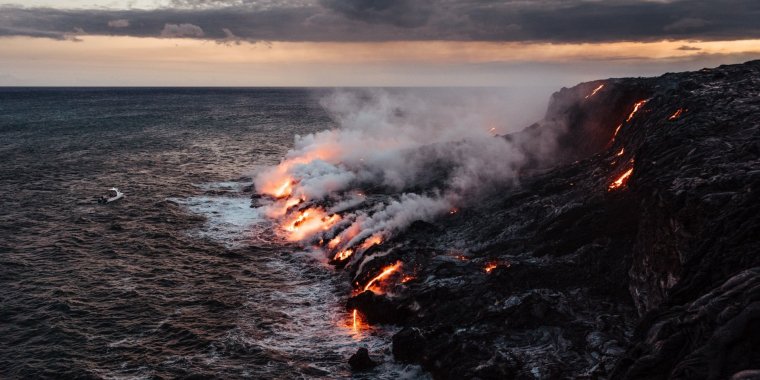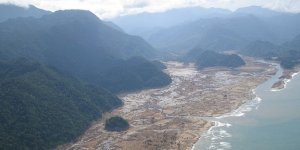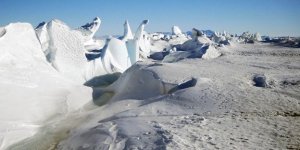| News / Science News |
Scientists track veil of toxic metals carried in Kīlauea’s gas plumes, revealing hidden dangers of volcanic pollution
The research is the most extensive survey of metal release from any volcano to date – helping scientists understand the spread of metal-rich volcanic fumes and the exposure of communities to volcanic air pollution around Hawai’i.

Lava from the Kilauea volcano hitting the ocean. Photo: Cedric Letsch/Unsplash
h perspective, “We don’t know much about these metal emissions at all, so this work is a key step to understanding the significant, yet underestimated, chemical risks of volcanoes,” said Emily Mason, PhD student at Cambridge Earth Sciences and lead author of one of the papers.
When volcanoes erupt they exhale a cocktail of gases – mostly steam, carbon dioxide and sulphur dioxide – laced with evaporated heavy metals, including lead and arsenic. To the communities living alongside volcanoes, these gases are often a considerable source of air pollution and the volatile metals they carry may have long-lasting impacts on both health and environment.
Volcanologists have been measuring volatile metal emissions from volcanoes for decades, but how these elements are dispersed in the atmosphere following an eruption, to later rain down on the landscape and be taken up in the environment through soils and water bodies, has remained poorly understood.
The team, including researchers from the University of Cambridge, report higher concentrations of airborne heavy metals within a 40 km radius of Kīlauea, meaning that communities living closer to the volcano were disproportionally exposed to metal pollution during the 2018 eruption.
They believe that the strong trade winds at the time of the eruption, combined with the topography of the local area, caused higher rainfall and, therefore metal deposition, closer to the vent. This could mean that an eruption in winter, when wind patterns are reversed, might result in a different distribution of metal deposition.
Their results could help delineate environmental monitoring strategies during and following eruptions – including the targeted testing of community water supplies in at-risk areas – as well as helping planners decide where to build safely around volcanoes.
Emily Mason was one of an all-female team of scientists from the Universities of Cambridge and Leeds that headed out to take gas measurements when Kīlauea erupted. Mason, together with then first-year PhD students Penny Wieser and Rachel Whitty, and early career scientists Evgenia Ilyinskaya and Emma Liu, arrived when the eruption was in full flow and some of their study area was already cut off by lava, “We had to fly in to one location via helicopter. I remember descending through a dense haze of volcanic gas…the acidic air actually stung our skin.” said Mason.
“We tend to think of the more immediate volcanic hazards like ash fall, pyroclastic flows, lava,” said Dr Evgenia Ilyinskaya, from the University of Leeds, who led the research on downwind metal dispersal, “But metal emissions, just like air pollution, are an insidious and often underestimated volcanic hazard – potentially impacting health over long periods.”
During the first few weeks of the eruption, the main air quality concern was volcanic smog, or ‘vog’, which contains mostly sulfur dioxide with traces of heavy metals and volcanic ash. But when molten lava reached the ocean and reacted with seawater it triggered new health warnings, as billowing white clouds of lava haze or ‘laze’ were released; carrying hydrochloric acid and toxic metals.
Working with collaborators from the USGS, the team took measurements of gases inside the laze and dry vog plumes from both the ground and the air, using specially-fitted drones. They even developed a back frame for their air filters, so they could move equipment quickly through areas where the air was thick with sulphur dioxide.
Mason and co-authors discovered that the two types of gas plume had a very different chemistry, “What really surprised us was the large amounts of copper in the laze plume…the impact of lava-seawater interactions on the biosphere may be significantly underestimated. It’s interesting to note that this type of plume was probably a common feature of the massive outpourings of lava throughout geological history – some of which have been linked to mass extinctions.”
Their long-term goal is to produce pollution hazard maps for volcanoes, showing at-risk areas for metal pollution, a method already used to communicate areas that might be at risk of other volcanic hazards, like lava flows, “Our research is just one part of the puzzle – the idea would be to understand all of these hazards in tandem”. (University of Cambridge)
YOU MAY ALSO LIKE





